Hungarian Soviet Republic
The Hungarian Soviet Republic, literally the Republic of Councils in Hungary (Hungarian: Magyarországi Tanácsköztársaság[2] or Magyarországi Szocialista Szövetséges Tanácsköztársaság)[3] was a short-lived (133 days) small communist rump state.[4] When the Republic of Councils in Hungary was established in 1919, it controlled only approximately 23% of the territory of Hungary's classic pre-World War I territories (325 411 km²).
Hungarian Soviet Republic Magyarországi Tanácsköztársaság | |||||||||
|---|---|---|---|---|---|---|---|---|---|
| March–August 1919 | |||||||||
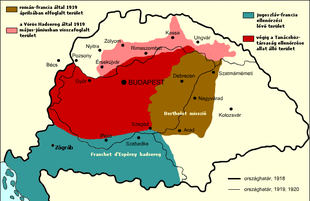 Map of territory of the former Kingdom of Hungary, May–August 1919
Controlled by Romania in April 1919
Controlled by the Soviet Republic of Hungary
Controlled by France and Yugoslav countries
Borders of Hungary in 1918
Borders of Hungary in 1920 | |||||||||
| Capital | Budapest 47.4833°N 19.0333°E | ||||||||
| Common languages | Hungarian | ||||||||
| Government | Soviet socialist republic | ||||||||
| Leader | |||||||||
• 1919 | Béla Kun | ||||||||
| Chairman | |||||||||
• 1919 | Sándor Garbai | ||||||||
| Legislature | National Assembly of Soviets | ||||||||
| Historical era | Interwar period | ||||||||
• Established | 21 March 1919 | ||||||||
• Constitution | 23 June 1919 | ||||||||
• Disestablished | 1 August 1919 | ||||||||
| Currency | Hungarian korona | ||||||||
| ISO 3166 code | HU | ||||||||
| |||||||||
It was the successor of the first Hungarian People's Republic and lasted only from 21 March to 1 August 1919. Though the de jure leader of the Hungarian Soviet Republic was president Sándor Garbai, the de facto power was in the hands of foreign minister Béla Kun, who maintained direct contact with Lenin via radiotelegraph. It was Lenin who gave the direct orders and advice to Béla Kun via constant radio communication with the Kremlin.[5] It was the second socialist state in the world to be formed, only preceded by the October Revolution in Russia which brought the Bolsheviks to power. The Hungarian Republic of Councils had military conflicts with the Kingdom of Romania, the Kingdom of Serbs, Croats and Slovenes and the evolving Czechoslovakia. It ended on 1 August 1919 when Hungarians sent representatives to negotiate their surrender to the Romanian forces. Due to the mistranslation, it is often referred to as "Hungarian Soviet republic" in English sources, despite the literal name was "Republic of Councils in Hungary" to avoid any strong ethnic connotation with Hungarian people.
Formation
As the Austro-Hungarian Monarchy collapsed in 1918, an independent Hungarian People's Republic was formed after the Aster Revolution. The official proclamation of the republic was on 16 November 1918 and Count Mihály Károlyi became its president. Károlyi struggled to establish the government's authority and to control the country. During the rule of Károlyi's pacifist cabinet, Hungary lost the control over approx. 75% of its former pre-WW1 territories (325 411 km²) without armed resistance and was subject to foreign occupation.
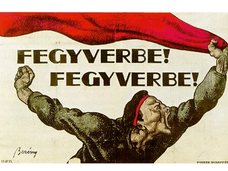
An initial nucleus of a Hungarian communist party had been organized in a hotel on 4 November 1918, when a group of Hungarian prisoners of war and other communist proponents formed a Central Committee in Moscow. Led by Béla Kun, the inner circle of the freshly established party returned to Budapest from Moscow on 16 November, 1918.[6] On 24 November they created the Party of Communists from Hungary (Hungarian: Kommunisták Magyarországi Pártja). The name was chosen instead of "The Hungarian Communist Party" because the vast majority of supporters were from the urban industrial working class in Hungary which at the time was largely made up of people from non-Hungarian ethnic backgrounds, with ethnic Hungarians only a minority in the new party itself.[7] The party recruited members while propagating its ideas, radicalising many members of the Social Democratic Party of Hungary in the process. By February 1919, the party numbered 30,000 to 40,000 members, including many unemployed ex-soldiers, young intellectuals and ethnic minorities.[8]
Kun founded a newspaper, called Vörös Újság ("Red News") and concentrated on attacking Károlyi's liberal government. The party became popular among the Budapest proletariat, it also promised that Hungary would be able to defend its territory even without conscription. Kun promised military help and intervention of the Soviet Red Army, which never came, against non-communist Romanian, Czechoslovak, French and Yugoslav forces. During the following months, the Communist Party's power-base rapidly expanded. Its supporters began to stage aggressive demonstrations against the media and against the Social Democratic Party. The Communists considered the Social Democrats as their main rivals, because the Social Democrats recruited their political supporters from the same social class: the industrial working class of the cities. In one crucial incident, a demonstration turned violent on 20 February and the protesters attacked the editorial office of the Social Democratic Party of Hungary' official paper, Népszava (People's Word). In the ensuing chaos, seven people, some policemen, were killed. The government arrested the leaders of the Communist Party,[8] banned Vörös Újság and closed down the party's buildings. The arrests were particularly violent, with police officers openly beating the communists. This resulted in a wave of public sympathy for the party among the masses of Budapester proletariat. On 1 March, Vörös Újság was given permission to publish again, and the Communist Party's premises were re-opened. The leaders were permitted to receive guests in prison, which allowed them to keep up with political affairs.
Coup d'état

On 20 March, president Mihály Károlyi announced that the Dénes Berinkey government would resign. The Berinkey government had been placed in an impossible position when it received a note from Paris ordering Hungarian troops to withdraw further their lines. It was widely assumed that the new military lines would be the postwar boundaries. Károlyi and Berinkley concluded that while accepting the note would endanger Hungary's territorial integrity, they were not in a position to reject it either.
On 21 March, Károlyi informed the Council of Ministers that only Social Democrats could form a new government, as they were the party with the highest public support in the largest cities and especially in Budapest. In order to form a governing coalition, Social Democrats started secret negotiations with the Communist leaders – who were still imprisoned – and decided to merge their two parties under the name of the Hungarian Socialist Party.[9] President Károlyi, who was an outspoken anti-Communist, was not informed about the fusion of the Communist and Social Democrat parties. Thus, while believing that he had appointed a Social Democratic government, he found himself faced with one dominated by Communists. Mihály Károlyi resigned on 21 March. Béla Kun and his communist friends were released from the Margit Ring prison on the night of 20 March 1919.[10] For the Social Democrats, an alliance with the KMP not only increased their standing with the industrial working class, but also gave them a potential link to the increasingly powerful Russian Communist Party, as Kun had strong ties with prominent Russian Bolsheviks. Following Lenin's model, but without the direct participation of the workers' councils (soviets) from which it took its name, the newly united Socialist Party created a government called the Revolutionary Governing Council, which proclaimed the Hungarian Soviet Republic and dismissed President Károlyi on 21 March. The liberal president Károlyi was arrested by the new Communist government on the first day; in July 1919 he managed to make his escape and flee to Paris.[11] On 23 March, Lenin gave an order to Béla Kun that Social Democrats must be removed from power, so that Hungary could be transformed into a true communist state ruled by a "dictatorship of the proletariat".[12] Accordingly, the Communists started to purge the Social Democrats from the government on the next day.[13][14]
The Garbai Government
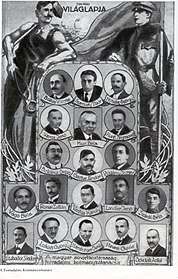
Sándor Garbai, Béla Kun, Vilmos Böhm, Tibor Szamuely, György Nyisztor, Jenő Varga, Zsigmond Kunfi, Dezső Bokányi, József Pogány, Béla Vágó, Zoltán Rónai, Károly Vantus, Jenő Landler, Béla Szántó, Sándor Szabados, György Lukács, Jenő Hamburger, Gyula Hevesi, Antal Dovcsák, and Gyula Lengyel.
In a radio dispatch to the Russian SFSR, Kun informed Lenin that a "dictatorship of the proletariat" had been established in Hungary and asked for a treaty of alliance with the Russian SFSR.[8] The Russian SFSR refused because it was itself tied down in the Russian Civil War.
The government was formally led by Sándor Garbai, but Kun, as Commissar of Foreign Affairs, held the real power, because only Kun had the acquaintance and friendship with Lenin. (He was the only person in the government who met and talked to Lenin during the Russian Revolution) and Kun kept the contact with the Kremlin via radio communication.
The ministries often rotated among the various members of the government.
- Sándor Garbai president and prime minister of the Hungarian Soviet republic
- Jenő Landler commissar for interior
- Sándor Csizmadia, Károly Vántus, Jenő Hamburger, György Nyisztor – commissars of agriculture
- József Pogany, later also Béla Szántó – commissars of Defense
- Zoltán Rónai, later also István Láday – commissars of Justice
- Jenő Landler – commissar for trade
- Mór Erdélyi, later also Bernát Kondor – commissars about food
- Zsigmond Kunfi, later also György Lukács, Tibor Szamuely, Sándor Szabados – commissars about education
- Béla Kun – commissar for foreign affairs
- Dezső Bokányi – commissar of labor
- Henrik Kalmár – commissar for German affairs
- Jenő Varga, later also Gyula Lengyel – commissars of Finance
- Vilmos Böhm – commissar for socialism, later also Antal Dovcsák
After the declaration of the constitution changes took place in the commissariat. The new ministries:
- Jenő Varga, Mátyás Rákosi, Gyula Hevesi, József Kelen, Ferenc Bajáki – commissars about economic product
- Jenő Landler, Béla Vagó – commissars about internal affairs, railways and navigation
- Béla Kun, Péter Ágoston and József Pogány – commissars for Foreign Affairs
Communist policies
.jpg)
This government consisted of a coalition of socialists and communists, but with the exception of Kun, all commissars were former social democrats.[15] Under the rule of Kun, the new government, which had adopted in full the program of the Communists, decreed the abolition of aristocratic titles and privileges; the separation of church and state; codified freedom of speech and assembly; and implemented free education and language and cultural rights to minorities.[8]
The Communist government also nationalized industrial and commercial enterprises and socialized housing, transport, banking, medicine, cultural institutions, and all landholdings of more than 40 hectares. Public support for Communists was also heavily dependent on their promise of restoring Hungary's former borders.[8] The government took steps toward normalizing foreign relations with the Triple Entente powers in an effort to gain back some of the lands that Hungary was set to lose in the post-war negotiations.
The Communists remained bitterly unpopular[16] in the Hungarian countryside, where the authority of that government was often nonexistent.[17] The communist party and communist policies only had real popular support among the proletarian masses of large industrial centers – especially in Budapest – where the working class represented a high proportion of the inhabitants.
The Hungarian government was thus left on its own, and a Red Guard was established under the command of Mátyás Rákosi.
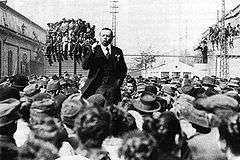
In addition, a group of 200 armed men – known as the Lenin Boys – formed a mobile detachment under the leadership of József Cserny. This detachment was deployed at various locations around the country where counter-revolutionary movements were suspected to operate. The Lenin Boys, as well as other similar groups and agitators, killed and terrorised many people (e.g. armed with hand grenades and using their rifles' butts they disbanded religious ceremonies).[18] They executed victims without trial.[19] This caused a number of conflicts with the local population, some of which turned violent.
The situation of the Hungarian Communists began to deteriorate in the capital city Budapest after a failed coup by the Social Democrats on 24 June, the newly composed Communist government of Sándor Garbai resorted to large-scale reprisals. Revolutionary tribunals ordered executions of people who were suspected of having been involved in the attempted coup. This became known as the "Red Terror", and greatly reduced domestic support for the government even among the working classes of the highly industrialized suburb districts and metropolitan area of Budapest.
Foreign policy scandal and downfall

In late May, after the Entente military representative demanded more territorial concessions from Hungary, Kun attempted to "fulfill" his promise to adhere to Hungary's historical borders. The men of the Hungarian Red Army were recruited from the volunteers of the Budapest proletariat.[20] In June, the Hungarian Red Army invaded the eastern part of the newly-forming Czechoslovak state (today's Slovakia), the former so-called "Upper Hungary". The Hungarian Red Army achieved some military success early on: under the leadership of Colonel Aurél Stromfeld, it ousted Czech troops from the north, and planned to march against the Romanian army in the east. Despite promises for the restoration of the former borders of Hungary, the communists declared the establishment of the Slovak Soviet Republic in Prešov on 16 June 1919.[21] After the proclamation of the Slovak Soviet Republic, the Hungarian nationalists and patriots soon realized that the new communist government had no intentions to recapture the lost territories, only to spread communist ideology and establish other communist states in Europe, thus sacrificing Hungarian national interests.[22] The Hungarian patriots in the Red Army and the professional military officers saw this as a betrayal, and their support for the government began to erode (the communists and their government supported the establishment of the Slovak Communist state, while the Hungarian patriots wanted to keep the reoccupied territories for Hungary). Despite a series of military victories against the Czechoslovak army, the Hungarian Red Army started to disintegrate due to tension between nationalists and communists during the establishment of the Slovak Soviet Republic. The concession eroded support of the communist government among professional military officers and nationalists in the Hungarian Red Army; even the chief of the general staff Aurél Stromfeld, resigned his post in protest.[23] When the French promised the Hungarian government that Romanian forces would withdraw from the Tiszántúl, Kun withdrew his remaining military units who had remained loyal after the political fiasco in Upper Hungary. However, following the Red Army's retreat from the north, the Romanian forces were not pulled back. Kun then unsuccessfully tried to turn the remaining units of the demoralized Hungarian Red Army on the Romanians. The Hungarian Soviet found it increasingly difficult to fight Romania with its small force of communist volunteers from Budapest, and support for both the war and the Communist Party was waning at home. After the demoralizing retreat from "Northern Hungary" (later part of Czechoslovakia), only the most dedicated Hungarian Communists volunteered for combat, and the Romanian army broke through the weak lines of the Hungarian Red Army on 30 July.
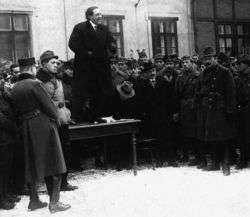
Béla Kun, together with other high-ranking Communists, fled to Vienna on 1 August[8] with only a minority, including György Lukács, the former Commissar for Culture and noted Marxist philosopher, remaining to organise an underground Communist Party.[24] The Budapest Workers' Soviet elected a new government, headed by Gyula Peidl, which only lasted a few days before Romanian forces entered Budapest on 6 August.[25][26][27]
In the power vacuum created by the fall of the Soviet Republic and the presence of the Romanian Army, semi-regular detachments (technically under Horthy's command, but mostly independent in practice) initiated a campaign of violence against Communists, leftists, and Jews, known as the White Terror.[28] Many supporters of the Hungarian Soviet Republic were executed without trial; others, including Péter Ágoston, Ferenc Bajáki, Dezső Bokányi, Antal Dovcsák, József Haubrich, Kalmár Henrik, Kelen József, György Nyisztor, Sándor Szabados, and Károly Vántus, were imprisoned by trial ("comissar suits"). Actor Bela Lugosi, the founder of the country's National Trade Union of Actors (the world's first film actor's union), managed to escape. Most were later released to the Soviet Union by amnesty during the reign of Horthy, after a prisoner exchange agreement between Hungary and the Russian Soviet government in 1921. In all, about 415 prisoners were released as a result of this agreement.[29]
Kun himself (along with an unknown number of other Hungarian communists) was executed during Joseph Stalin's Great Purge of the late 1930s in the Soviet Union, to which they had fled in the 1920s.[8]
See also
Footnotes
- Angyal, Pál (1927). "A magyar büntetőjog kézikönyve IV. rész". A magyar büntetőjog kézikönyve. Archived from the original on 4 March 2016. Retrieved 19 January 2012.
- A Forradalmi Kormányzótanács XXVI. számú rendelete (in Hungarian)
- Official name of the state between 23 June and 1 August according to the constitution, see: A Magyarországi Szocialista Szövetséges Tanácsköztársaság alkotmánya (in Hungarian)
- John C. Swanson (2017). Tangible Belonging: Negotiating Germanness in Twentieth-Century Hungary. University of Pittsburgh Press. p. 80. ISBN 9780822981992.
- Arthur Asa Berger (2017). The Great Globe Itself: A Preface to World Affairs. Routledge. p. 85. ISBN 9781351481861.
- Mary Jo Nye (2011). Michael Polanyi and His Generation: Origins of the Social Construction of Science. University of Chicago Press. p. 13. ISBN 9780226610658.
- E. Raffay, Trianon Titkai (Secrets of Trianon), Szikra Press, Budapest 1990 (ISBN 9632174771), page 13.
- The Library of Congress Country Studies – Hungarian Soviet Republic
- Borsanyi, Gyorgy, The life of a Communist revolutionary, Bela Kun, translated by Mario Fenyo; Social Science Monographs, Boulder, Colorado; Columbia University Press, New York, 1993, p178.
- Howard Morley Sachar (2007). Dreamland: Europeans and Jews in the Aftermath of the Great War. Knopf Doubleday Publishing Group. p. 409. ISBN 9780307425676.
- Spencer C. Tucker (2014). World War I: The Definitive Encyclopedia and Document Collection [5 volumes]: The Definitive Encyclopedia and Document Collection. ABC-CLIO. p. 867. ISBN 9781851099658.
- John Rees (1998). The Algebra of Revolution: The Dialectic and the Classical Marxist Tradition. Psychology Press. p. 255. ISBN 9780415198776.
- David A. Andelman (2009). A Shattered Peace: Versailles 1919 and the Price We Pay Today. John Wiley & Sons. p. 193. ISBN 9780470564721.
- Timothy C. Dowling (2014). Russia at War: From the Mongol Conquest to Afghanistan, Chechnya, and Beyond. ABC-CLIO. p. 447. ISBN 9781598849486.
- Janos, Andrew C. & Slottman, William (editors) Revolution in perspective: essays on the Hungarian Soviet Republic of 1919, Center for Slavic and East European Studies, University of California, Berkeley, 1971, p. 68.
- Robin Okey (2003). Eastern Europe 1740-1985: Feudalism to Communism. Routledge. p. 162. ISBN 9781134886876.
- John Lukacs (1990). Budapest 1900: A Historical Portrait of a City and Its Culture. Grove Press. p. 2012. ISBN 9780802132505.
- Kodolányi, János (1979) [1941]. Süllyedő világ (in Hungarian). Budapest: Magvető. ISBN 978-963-270-935-2. OCLC 7627920.
- See resources in the article Red Terror.
- Eötvös Loránd University (1979). Annales Universitatis Scientiarum Budapestinensis de Rolando Eötvös Nominatae, Sectio philosophica et sociologica, Volumes 13-15. Universita. p. 141.
- Jack A. Goldstone (2015). The Encyclopedia of Political Revolutions. Routledge. p. 227. ISBN 9781135937584.
- Peter Pastor (1988). Revolutions and Interventions in Hungary and Its Neighbor States, 1918-1919, Volume 20. Social Science Monographs. p. 441. ISBN 9780880331371.
- Peter F. Sugar; Péter Hanák; Tibor Frank (1994). A History of Hungary. Indiana University Press. p. 308. ISBN 9780253208675.
- Borsanyi, Gyorgy, The life of a Communist revolutionary, Bela Kun, translated by Mario Fenyo; Social Science Monographs, Boulder, Colorado; Columbia University Press, New York, 1993, p205.
- "Magyar Tudomány 2000. január". Epa.niif.hu. Retrieved 21 November 2008.
- Ignác Romsics: Magyarország története a XX. században, 2004, p. 134.
- "Hungary: Hungarian Soviet Republic". Library of Congress Country Studies. September 1989. Republished at geographic.com. Retrieved 7 October 2010.
- ""White Terror" in Hungary 1919-1921". Armed Conflict Events Database. 16 December 2000. Retrieved 7 October 2010.
- 2000 - Bűn És Bűnhődés Archived 30 May 2007 at the Wayback Machine
Further reading
- Gioielli, Emily R. "'White Misrule': Terror and Political Violence During Hungary’s Long World War I, 1919-1924. (PhD Diss. Central European University, 2015) online
- György Borsányi, The life of a Communist revolutionary, Bela Kun translated by Mario Fenyo, Boulder, Colorado: Social Science Monographs, 1993.
- Andrew C. Janos and William Slottman (editors), Revolution in Perspective: Essays on the Hungarian Soviet Republic of 1919. Berkeley, CA: University of California Press, 1971.
- Bennet Kovrig, Communism in Hungary: From Kun to Kádár. Stanford University: Hoover Institution Press, 1979.
- Bela Menczer, "Bela Kun and the Hungarian Revolution of 1919," History Today, vol. 19, no. 5 (May 1969), pp. 299–309.
- Peter Pastor, Hungary between Wilson and Lenin: The Hungarian Revolution of 1918–1919 and the Big Three. Boulder, CO: East European Quarterly, 1976.
- Thomas L. Sakmyster, A Communist Odyssey: The Life of József Pogány. Budapest: Central European University Press, 2012.
- Sándor Szilassy, Revolutionary Hungary, 1918–1921. Astor Park, FL: Danubian Press, 1971.
- Rudolf Tokes, Béla Kun and the Hungarian Soviet Republic: The Origins and Role of the Communist Party of Hungary in the Revolutions of 1918–1919. New York: F.A. Praeger, 1967.
- Ivan Volgyes (editor), Hungary in Revolution, 1918–19: Nine Essays Lincoln, NE: University of Nebraska Press, 1971.
- Ferenc Tibor Zsuppán, "The Early Activities of the Hungarian Communist Party, 1918-19," Slavonic and East European Review, vol. 43, no. 101 (June 1965), pp. 314–334.
.svg.png)
